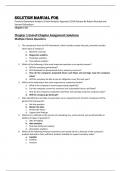Solution Manual For
Financial Statement Analysis A Data Analytics Approach 2024 Release By Robert Resutek and
Vernon Richardson
Chapter 1-10
Chapter 1 End-of-Chapter Assignment Solutions
Multiple Choice Questions
1. The component from the FSA framework, which includes master the past, primarily includes
which type of analytics?
a. Machine Learning
b. Diagnostic analytics
c. Predictive analytics
d. Prescriptive analytics
2. Which of the following is the most important question to an equity investor?
a. Will the company go bankrupt?
b. Will dividends be discontinued due to solvency concerns?
c. How do the company’s projected future cash flows and earnings map into company
value?
d. Will the company be able to pay its obligations over the next year?
3. Which of the following is the most important to a potential lender?
a. What is the company’s revenue-generating capability?
b. Can the company convert its revenues into sustainable future cash flows?
c. How do the company’s projected cash flows and earnings map into company value?
d. Will the company go bankrupt?
4. Data identification and data incorporation are an important part of which component of the
general FSA framework?
a. Ask the question
b. Master the data
c. Predict the future
d. Support the findings
5. What term is defined as the process of evaluating raw, unstructured, and unrefined data to
address all types of questions?
a. data wrangling
b. data analytics
c. financial statement analysis
d. descriptive analytics
6. Which of the following financial statement user would ask for a forecast of the company’s
product demand to have sufficient product available to support company sales?
a. Supplier
b. Creditor
c. Investor
, d. Employee
7. Porter’s five forces are primarily used to evaluate the company’s ____ .
a. financial statements
b. strategic positioning
c. competitive environment
d. capital structure
8. Which of the following are one of Porter’s five forces?
a. Power of competitor
b. Bargaining power of buyers
c. Strength of the economy
d. Supplier’s financial position
9. Which of Porter’s five forces addresses the ease of switching from one competitor to another?
a. Power of competitor
b. Threat of substitute products or services
c. Strength of the economy
d. Supplier’s financial position
10. A company that competes on the basis of cost is more likely to have a ______ advantage, as
compared to its competitors.
a. comparative
b. differential
c. opportunistic
d. niche
Discussion Questions
1. What data might an analyst use in addition to the financial statements, to address a company’s
FSA questions?
Potential solution: Answers will vary, but include competitor financial statements, industry
reports, company SEC filings, regulatory filings, other analyst forecasts, conference calls,
customer financial statements, press releases, product reviews, etc.
2. Most accounting courses/curriculums focus on carefully measuring the past. Why is that
important in predicting the future and ultimately addressing the most important FSA questions?
Potential solution: In general, we expect persistence between past performance and future
performance. To the extent that we can carefully measure the past, our expectation is that will
be a key input into forecasting the future.
3. Why is forecasting sales so important for an analyst? Why is it considered to be one of the most
important FSA questions?
Potential solution: Generally the first input into a model forecasting earnings and cash flows is
the sales forecast. That will help a company determine how much product to produce, and how
profitable a company will be.
4. What is the difference between predictive and prescriptive analytics? Why does financial
statement analysis employ both, and how do they complement each other?
, Potential solution: While predictive analytics works to form expectations of the future by
forecasting future performance, prescriptive analytics takes the predictive analytics further by
addressing questions of ‘What should we do given our predictions of the future?” or “What
should we do if our predictions of the future change?”. Prescriptive analytics is analytics that
inform on the best action given a specific set of assumptions and constraints. In financial
statement analysis, we predict future sales, earnings and cash flows using predictive analytics,
and then value those cash flows using prescriptive analytics.
5. Why is sensitivity analysis considered to be prescriptive analytics?
Potential solution: Sensitivity analysis is used to tell how much the outcome will change based
on various assumptions. Since prescriptive analytics help the analyst understand what to do
based on predictions, the assumptions made in predictive analytics are key to ultimately
deciding whether to go forward with a decision (such as buying or selling a stock). That is,
prescriptive analytics is analytics that inform on the best action given a specific set of
assumptions and constraints.
6. What is the difference between a company’s competitive environment and its strategic
positioning?
Potential solution: A firm’s competitive environment describes the economic dynamics and
forces that affect different facets of a firm’s industry and business model. A firm’s strategic
positioning is the result of a set of carefully considered decisions by the firm to position it within
its industry to maximize profits. A firm’s strategic positioning is often a response to its
competitive environment.
7. Which of Porter’s five forces would you think most affects the competitive environment for
Apple Inc? Or for Tesla?
Potential solution: Answers will vary. With such a strong competitor in Samsung and its
Android (Google) operating system, rivalry among existing competitors is likely the one of
Porters five forces that most affects its competitive environment. While Apple works to
differentiate their product, there is still a strong competitor in Samsung and Google. Tesla
likewise has strong competitors and attempts to differentiate their luxury car in the electric
vehicle space.
8. Comparing Walmart to Target, which is likely to have a cost advantage and which is likely to
have a differential advantage?
Potential solution: With Walmart’s “Every Day Low Price (EDLP)” as the cornerstone mantra of
Walmart’s corporate strategy, the corporation conveys to customers that every item that
Walmart sells is always at the lowest price that Walmart can offer. To generate sustainable
profits with a cost leadership strategy, Walmart relies on selling higher volumes than its
competitors. Target however, focuses less on cost and more on product offering and product
differentiation. For this reason, Walmart is likely to have a cost advantage, and Target is more
likely to have a differential advantage.
Brief Exercises
, 1. (LO 1-1; 1-2) Match the financial statement user (e.g., investor, creditor, supplier,
manager, customer, employee) to the specific question, “What is the company’s
revenue-generating capability?”.
Specific financial user Financial Statement User
question (e.g., investor, creditor,
supplier, manager,
customer, employee)
Will our current capacity be Manager
able to produce the expected
number of products?
Will we have enough product Supplier
available to support our
customer’s level of sales?
Will the company sell enough Creditor
product to stay in business
and pay their loans?
Will the company achieve the Investor
expected revenue growth to
support the current stock
price?
Will the projected company Employee
growth allow sufficient job
opportunities in the future?
Will there continue to be Customer
new, innovative products in
the future available for
purchase?
2. (LO 1-1; 1-2) Match the analytics type (e.g., descriptive, diagnostic, predictive, and prescriptive)
with the example financial statement analysis questions.
Example Financial Statement Analysis Analytics Type (e.g., descriptive, diagnostic,
Questions predictive or prescriptive analytics)
Did the amount of interest expense as a Descriptive
percentage of sales increase in the past year?
How did the company’s return on assets Diagnostic
compare to the industry as a whole?





